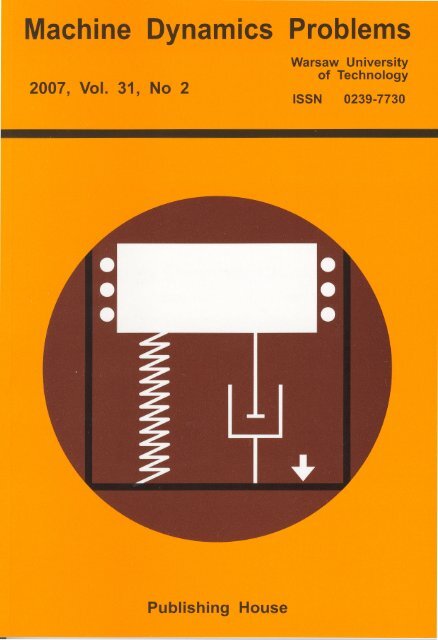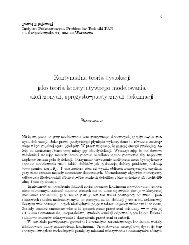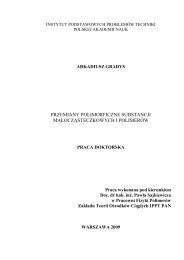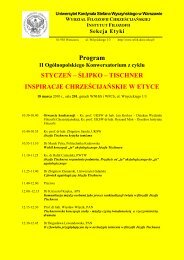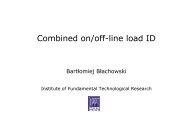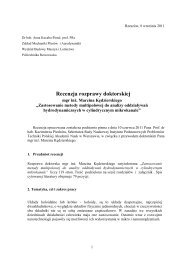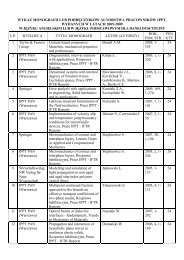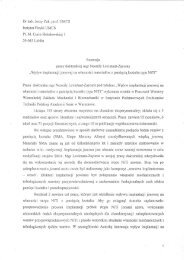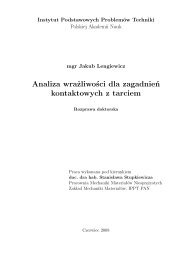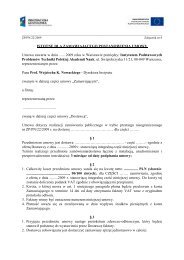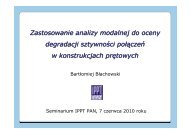Machine Dynamics Problems
Machine Dynamics Problems
Machine Dynamics Problems
You also want an ePaper? Increase the reach of your titles
YUMPU automatically turns print PDFs into web optimized ePapers that Google loves.
<strong>Machine</strong> <strong>Dynamics</strong> <strong>Problems</strong><br />
2007, Vol. 31, No 2<br />
Warsaw University<br />
of Technology<br />
ISSN 0239-7730<br />
Publishing<br />
House
<strong>Machine</strong> <strong>Dynamics</strong> <strong>Problems</strong><br />
2007, Vol. 31, No 2<br />
Contents<br />
Roman Bogacz<br />
On Recent Investigations in <strong>Dynamics</strong> of Continuous Systems Subjected to<br />
Travelling Loads 7<br />
Roman Bogacz, Kurt Frischmuth<br />
On the Stability of Columns as Part of Constructions 13<br />
Eberhard Brommundt<br />
A Simple Model for Friction Induced High-Frequency Self-Excitation of Paper<br />
Calenders 25<br />
Andrzej Chudzikiewicz<br />
Shifting Wheelset 46<br />
Krzysztof Czolczynski, Andrzej Stefanski, Przemyslaw Perlikowski,<br />
Tomasz Kapitaniak<br />
<strong>Dynamics</strong> of an Array of Duffing Oscillators Suspended on Elastic Structure 57<br />
Bartlomiej Dyniewicz, Czeslaw I.Bajer<br />
Discontinuous Trajectory of the Mass Particle Moving on a String or a Beam 66<br />
Horst Irretier<br />
Numerical Simulation of Transient Resonance Vibrations of a Rigid Rotor in<br />
Roller Bearings with Clearance (extended abstract) 80<br />
Matthias Kroger, Gunnar Glibel, Patrick Moldenhauer<br />
Experimental Results and Models of the Tire/Road Contact 84<br />
Igor Maciejewski, Tomasz Krzyzynski<br />
Research and Development of the Seat Suspensions for Working<br />
<strong>Machine</strong>s Operators Health Protection against Vibration 95<br />
Michael Miiller, Georg-Peter Ostermeyer<br />
A Three-Dimensional Cellular Automaton Model to Describe the Interface<br />
<strong>Dynamics</strong> of Brake Systems 104<br />
Georg-Peter Ostermeyer, Katrin Fischer<br />
Mesoscopic Particles - A new Approach for Contact and Friction <strong>Dynamics</strong> 117<br />
Andrzej Tylikowski<br />
Semiactive Control of a Shape Memory Alloy Hybrid Composite Shaft under<br />
a Torsional Load 128<br />
Vtz von Wagner<br />
Stochastically Excited Nonlinear Systems 140<br />
Thepapers of this issue appear in original version of text submitted by authors.
<strong>Machine</strong> <strong>Dynamics</strong> <strong>Problems</strong><br />
2007, Vol. 31, No 2, 66-79<br />
Discontinuous Trajectory of the Mass Particle<br />
Moving on a String or a Beam<br />
Bartlomiej Dyniewicz, Czeslaw 1. Bajer<br />
Polish Academy of SciencesI<br />
cbajer@ippt.gov.pl<br />
Abstract<br />
The paper deals with a new solution of the string or beam vibrating under a moving<br />
mass. Numerous solutions published up to date exhibit incorrect solutions. Moreover, they<br />
are not sufficiently simple and can not be applied to a whole range of the mass speed, also<br />
in over-critical range. We propose the solution of the problem that allows us to reduce the<br />
problem to the second order matrix differential equation. Its solution is characteristic of all<br />
features of the critical, sub-critical and over-critical motion. Results exhibit discontinuity of<br />
the mass trajectory at the end support point. The closed solution in the case of massless<br />
string is analysed and the discontinuity is mathematically proved. Numerical results<br />
obtained for inertial string demonstrate similar features. Small vibrations are analysed and<br />
that is why the effect discussed in the paper is of pure mathematical interest. However, the<br />
phenomenon can increase the complexity in discrete solutions.<br />
1. Introduction<br />
Inertial moving loads are frequently treated in engineering problems. Some<br />
problems as train-track interaction, vehicle-bridge interaction, pantograph<br />
collectors in railways, magnetic rails, guideways in robotic solutions, etc. are of<br />
real practical importance. The problem has been widely treated in literature (e.g.<br />
Szczesniak, 1990; Fryba, 1972). Recent papers contribute the analysis of complex<br />
problems of structures subjected to moving inertial load (Jia-Jang Wu, 2005) or<br />
oscillator (Metrikine and Verichev, 2001; Pesterev et aI., 2003; Biondi and<br />
Muscolino, 2005). Variable speed was analysed in (Andrianov and Awrejcewicz,<br />
2006; Michaltsos, 2002). Unfortunately, the beam is subjected by massless forces.<br />
Equivalent mass influence is analysed by Gavrilov, 2006). However, detailed<br />
investigation in the field does not result in numerical procedures implemented to<br />
commercial codes. One can perform a simulation of extremely complex problems<br />
except problems with moving loads.<br />
I Institute of Fundamental Technological Research.
Discontinuous Trajectory of the Mass Particle Moving on a String or a Beam 67<br />
We must emphasise here that string or bar vibrations represent purely<br />
hyperbolic differential equation, with all attributes of wave front propagation.<br />
Beams, both Bernoulli-Euler and Timoshenko type, exhibit additionally parabolic<br />
properties of the solution. In this case final results and diagrams have strong<br />
contribution of bending and wave phenomena are diluted by low gradient bending.<br />
This is the reason why the beam bending problem always results in acceptable<br />
trajectories. Differences between theoretically correct solution and those obtained<br />
by a certain approach in the case of low range speed moving mass are not well<br />
visible. Most of results are accepted; even they do not give correct solutions. The<br />
crucial point in the formulation of the term contributing the moving mass into the<br />
differential equation is the difference between o(vt, t)8 2 u(x,t) /8t 2 and<br />
8(vt,t)8 2 u(vt,t)/ 8t 2 • Further implementation to the first case term of the socalled<br />
Renaudot formula, which in fact is the chain rule derivative, does not result<br />
in the identical [mal mathematical form as in the case of the second term.<br />
In the paper we present two different approaches to the problem of moving<br />
mass (Fig. 1). The first one is derived from the purely mathematical analysis<br />
performed by the Fourier method. The second one is based on the Lagrange<br />
equation of the second type.<br />
N<br />
N<br />
Fig. 1. Moving inertial load<br />
Both ways result in identical [mal solution. The resulting differential equation<br />
allows us to describe and solve the string motion in a whole range of the velocity:<br />
under-critical, critical and over-critical. The mass motion exhibits discontinuity at<br />
the end support. The same phenomenon can be demonstrated in the case of the<br />
Timoshenko beam. The Bernoulli-Euler beam model is free of this feature.<br />
2. Mathematical analysis<br />
2.1. The Fourier solution<br />
The solution can be obtained by direct mathematical solving of the original<br />
equation (9), see Dyniewicz and Bajer (2007). In order to reduce partial differential<br />
equation to ordinary differential equation, we apply Fourier sine integral<br />
transformation in a finite range (i.e. finite length of the string), (1), (2):
68 B. Dyniewicz, c.t. Bajer<br />
V(j,t)<br />
I .<br />
= fu(x,t)sin~<br />
o<br />
I<br />
(1)<br />
2 00 •<br />
u(x,t)=- L:V(j,t)sin J7lX<br />
I j=1<br />
I<br />
(2)<br />
We can present each of the functions as a infmite sum of sine functions (2) with<br />
respective coefficients (1). Then the expansion of the moving mass acceleration in<br />
a series has a form<br />
f;2u(vt,t) _ 2 L oo [V"(k ) . brut 2k1ru V '(k) brut e,,2v 2 V(k ) . k"vt]<br />
-~----'--- t sm--+-- t cos--- t Sill--<br />
8t2 [ k=1 ' l I , l [2 ' l<br />
The integral transformation (1) of the equation (9) with consideration of (3) can be<br />
performed<br />
/,,2 .. jnct a 2 u(vt t) I jttx<br />
N- 2<br />
-V(j,t) + pAV(j,t) =Psin-- m 2' fS(x - vt)sin-dx<br />
I I 8t 0 I<br />
(4)<br />
The integral with delta Dirac function in the above equation is as follows<br />
(3)<br />
I . .<br />
f S(x - vt) sin J 7lX dx = sin J "ut<br />
o I I<br />
(5)<br />
Let us consider now (3) and (5):<br />
/" 2 .. j "ut 2m 00 .. km» j mx<br />
N-<br />
I<br />
- 2<br />
-V(j,t) + pAV(j,t) = PSin- Z<br />
- --l-~V(k,t)sin-Z-sin-Z--<br />
2m ~ Zkstu V·(k) k"vt. j mx 2m ~ k 2,,2 v 2 V(k ) . kmx . j "vI<br />
--L,...-- ,t cos--sm--+-L,... 2 ,t sm--sm--<br />
I k=1 I I I I k=1 I I I<br />
(6)<br />
Finally, the motion equation after Fourier transformation<br />
can be written<br />
00 00<br />
pAV(j,t) + a L:V(k,t) sin liJktsin liJjt + 2a L:liJkV(k,t) COSliJkt sin liJjt +<br />
k=1 k=1<br />
00<br />
+ o'rt], t) - a L:liJ;V(k, t) sin liJktsin liJjt = Psin liJ}<br />
k=1<br />
(7)<br />
where
Discontinuous Trajectory of the Mass Particle Moving on a String or a Beam 69<br />
OJk =-,-,<br />
klru<br />
j7ru<br />
OJ· =--<br />
2.2. The Lagrange equation<br />
) "<br />
2m<br />
a=-,<br />
(8)<br />
Let us consider a string of the length I, cross-sectional area A, mass density p,<br />
tensile force N, subjected to a mass m accompanied by a force P (Fig. 1), moving<br />
with a constant speed v. The motion equation of the string under moving inertial<br />
load with a constant speed v has a form<br />
N a2u(x,t) .A a2 u(x,t) S:( )P S:( ) a 2 u(vt,t)<br />
- + P£1 =u x-vt -u x-vt m---'-___:'_":'"<br />
ax 2 at 2 at 2 (9)<br />
We impose boundary conditions<br />
u(O,t)=O, u(l,t)=0 (10)<br />
and initial conditions<br />
u(x,O) = 0', 8u(X,t)1 = °<br />
(11)<br />
at (;0<br />
The kinetic energy of a string and a travelling mass is described by the equation<br />
(12)<br />
where<br />
E =_!_m[8u(vt,t)]2<br />
km 2 at<br />
(13)<br />
contributes the kinetic energy of the moving mass. The potential energy of the<br />
string can be determined by computing of the ox to os change of its infinitesimal<br />
segment. The work N(& - &) integrated III space allow us to compute the<br />
potential energy of the string<br />
'{<br />
Ep = , IN(&-&)=NJ<br />
o 0<br />
We apply the expansion of (14) into the Maclaurin series and we consider only the<br />
first term of it<br />
(14)
70 B. Dyniewicz, Cl. Bajer<br />
If we neglect next terms of the series, we assume higher powers of au(x,t)/fJx to be<br />
nearly equal to zero. The equation (15) can be applied to the problem of small<br />
displacements of the string only. Finally the potential energy of the system, i.e. the<br />
string and the moving constant force P gains a form<br />
E p =~NI[<br />
au~:,t)<br />
rdx - PU(UI,t) (16)<br />
The examined string has a finite length. It is convenient to use standing waves for<br />
description of its displacements. We assume the solution in the following form:<br />
co<br />
utx, I) = LUi(x)~i(t)<br />
i=1<br />
(17)<br />
~i (I) are the generalized coordinate functions. In order to compute both the kinetic<br />
and the potential energy and to determine its derivatives required, we express them<br />
by generalized coordinates. We derive first the equation (17) with respect to 1<br />
(18)<br />
and with respect to spatial variable x<br />
The displacement<br />
by the equation.<br />
au(x, t)<br />
ax<br />
co<br />
LU:(x)~i(t)<br />
i=1<br />
(19)<br />
of the string in the contact point with a travelling mass is given<br />
co<br />
U(UI,/) = LUi<br />
i=1<br />
(UI)~i (I)<br />
The transverse velocity of the moving mass is expressed by a composite derivative.<br />
It expresses the load travelling along the string<br />
(20)<br />
Ou\~:,t)= UtVli(X)~i(t)\x=Lt +tv<br />
i(X)~i(t)\x=1A (2\)<br />
A.ccording to the above equation th.e ve\ocit'y ou(vt,t)/ot is expressed as a function<br />
of both generalized coordinates and the derivative of generalized coordinates with<br />
respect to time
72 B. Dyniewicz, c.i. Bajer<br />
Finally the potential energy of the string, with respect to (25) can be described by<br />
the equation<br />
2<br />
Ep = l_NfI i ~2 q/ (I) - P'I qj(I) sin inix<br />
4 i=1 l i=1 /<br />
Now, when we have kinetic and potential energy described in generalized<br />
coordinates and the derivative of generalized coordinates with respect to time, we<br />
can formulate the Lagrange equation, which general form is given by the equation.<br />
(30)<br />
(31)<br />
In order to obtain the Lagrange equation describing our problem, we must compute<br />
respective required terms. From (13) and (22) we have derivative of kinetic energy<br />
of travelling mass Ekm with respect to qi and ~i .<br />
(32)<br />
(33)<br />
We compute the derivative of the kinetic energy for hole system (26) with respect<br />
to qi and ~i , taking into account (32) and (33).<br />
8£ k 8£km [2 ~ ij Jr2 irax jmn j: ( ) ~ in iJrut. imn j: ( )]<br />
--=--=m u £...,.--cos--cos--.". t +u£...,.-cos--sm--.". t<br />
8;i O;i ;,}=1 [2 I 1 J i,}=1[ [ [J<br />
es, 1 00. 8£ 1 00. [00 jr: imx imx<br />
-. =-pA[L;;(t)+~=-pAIL;;(t)+m u L -sin-cos-;;(t)+<br />
O;i 2 ;=1 8;; 2 ;=1 ;,}=1 I I I<br />
(34)<br />
~ jtt , invt . invt j; ()~<br />
+ c: -Sln--Sln--." .,t<br />
i,}=1 / I I J<br />
The derivative of the potential energy (30) with respect to generalized<br />
qj.<br />
8E 1 00.2 2 00'<br />
p _ 7\TI" 1 Jr t: () p'" isto:<br />
----lV,£...,.--." t - L,.sm--<br />
8qi 2 i=1 /2 1 i=1 I<br />
(35)<br />
coordinates<br />
(36)<br />
The derivative of (35) with respect to t is as follows.
Discontinuous Trajectory of the Mass Particle Moving on a String or a Beam 73<br />
d (8Ek J 1 00 •• {oo jnu d [. imn jmx ]<br />
dt Oqi 2 i=1 i,j=1 I dt I I<br />
- -. =-pAt'[_qi(t)+m L -- sm-cos--qj(t) +<br />
~ d [. inix . jmn j: ()]}<br />
+ L., - sm--sm--,",j t<br />
i,j=1dt I I<br />
(37)<br />
Finallythe Lagrange equation (31) in the case of our problem of the inertial string<br />
subjectedto moving inertial force has a following form<br />
1 «>.. 00 jttu d [. imx jJrut] 00 jno . imx jms ,<br />
- pAt'I,c;i(t) + m L -- SIO-COS-- c;/t) + m L -sm-cos--q/t) +<br />
2 i=1 i,j=1 / dt / / i,j=1 I / /<br />
00 d [. i mx . j mxf 00 • imx . j mx .. 1 00 i 2 st 2<br />
+m L - SID-SIQ-- jet) +m LSID-SID--C;j(t)+-N/L-2-~i(t)-<br />
i,j=l dt I I i,j=1 I I 2 i=1 I<br />
-m u 2 L -2-COS--cos--qj(t)+u L -cos--sm--~/t) =PLSID--<br />
[<br />
where<br />
00 ij Jr2 tmx j Jrut 00 ir: iJrut. j mx , ] 00. imx<br />
i,j=1 I I I i,j=1 I I I i=1 I<br />
(38)<br />
d [. imx j Jrut ] iJrU i mx j mJt j JrU . imJt . j mx<br />
- sm--cos-- =-cos--cos-----sm--sm--<br />
dt I I I I I I I I<br />
(39)<br />
d [. imx . j Jrut] inu iJrut. j mx j JrU . imx j mx<br />
- sm--sm-- =-cos--sm--+--sm--cos--<br />
dt I I I I I I I I<br />
(40)<br />
We have the differential equation of variable coefficients. Finally (38) can be<br />
written in a following form<br />
:i ( ) 2m ~:i<br />
'"' t +-L.,,",'<br />
() . imx . jmx<br />
t sm--stn--+--L.,<br />
4m ~ iJru ~ () . imx<br />
. t sm--cos--+<br />
jmx<br />
I pAl j=l J I I pAl j=l I J I I<br />
N i 2 Jr2 ): ( ) 2m ~ j 2 Jr 2 U 2 ): () . ino: . jmx 2P. imx<br />
---,",' t ---L., ,",' t sm--sm--=--sm--<br />
pA 12 I pAl j=l 12 J I I pAl I<br />
(41)<br />
These two methods lead us to the identical differential equation of variable<br />
coefficients (41).<br />
2.3. The massless string<br />
We can consider the particular case of our problem: the massless string. The<br />
solution is given by a sum and can be derived from our solution (38). This<br />
particular solution first was published by Stokes in the case of the beam (Stokes,<br />
1883),then by Smith (1964) and Fryba (1972) for massless string:
74 B. Dyniewicz, Cil. Bajer<br />
y(r) =~r(r -1)I,fI (a + i -1)~b+ i-I) rk<br />
a-I k=1i=1 C + I -1 k!<br />
(42)<br />
where t: = vt / I > 0 is time parameter, a = Nl /(2mv2) > 0 determines the<br />
dimensionless parameter. Parameters a, band c are given below:<br />
a _3±~ b _3+~ c=2<br />
1,2 - 2 1,2 - 2 ' (43)<br />
In the case of a = 1 the initial problem has a closed solution. Here we consider the<br />
case of aot:1.<br />
Proof<br />
In (42) we will include the term r(t: - t) into the sum. Thus the equation can be<br />
reduced to the following form:<br />
(l_r)i;(ak)(bk) rk =abr + i;(ak-1)(bk-1)((a+k-l)(b+k-l) _l)_r_k_ (44)<br />
k=1 (ck) k! C k=2 (C k - 1 ) k(c+k-l) (k-l)!<br />
In the above relation (a k ) = a(a + 1)...(a + k -1), (b k ) = b(b + 1)...(b + k -1) and<br />
(c k ) = cCc + 1)...(c + k -1). By using Rabbe criterion one can show that for<br />
a + b < c + 2 the limit<br />
1· [4a (1 )~l1k (a+i-l)(b+i-l)rk ]. fi .<br />
un --r - t: L" IS Illite.<br />
r~l a-I k=1i=1 C + i-I k!<br />
Now we can estimate the value of the sum (44). The sum of the first two-three<br />
terms, depending on parameters, including abilc, is positive. Next terms are all<br />
positive (remember, that P is negative in our numerical example). This proves that<br />
the sum (44) is finite and is greater than O.<br />
·0.5<br />
0<br />
.§<br />
·1<br />
·1.5<br />
Fig. 2. Comparison of particle's trajectory moving on massless and inertial string<br />
v1IL
Discontinuous Trajectory of the Mass Particle Moving on a String or a Beam 75<br />
We can observe the same properties of the solution in the case of inertial string.<br />
Comparative plot is presented in Fig. 2. We can emphasise that in the case of lower<br />
m/pAI ratio the coincidence of each pair of curves is higher. However, analytical<br />
proof of discontinuity in the case of inertial string is impossible to be obtained,<br />
because of the numerical integration stage.<br />
2.4. The beam under the moving mass<br />
The motion of the Bernoulli-Euler<br />
equation<br />
beam under the moving mass is described by the<br />
El a4u(x,t) .,1 a 2 u(x,t) _ 5:( )P 5:( ) a 2 u(vt,t)<br />
-~.:........:... + p/1. - U X - vt - u X - vt m -~__:__;_<br />
&4 &2 &2<br />
(45)<br />
with boundary conditions<br />
u(O,t) =0, u(/,t) = 0, =0, =0 (46)<br />
and initial conditions<br />
x=o x=1<br />
u(x,O) = 0, au(x,t)1 =0<br />
(47)<br />
at /=0<br />
The Fourier transform method carried on in a way as in the case of the string<br />
results in he following equation<br />
where<br />
00 00<br />
V(j, t) + a "LV(k, t) sin {i)kt sin (i)/ + 2a"L (i)kV(k, t) cos (i)kt sin (i)/ +<br />
k=1 k=1<br />
+ Q 2 V(j,t) - f.{i)iV(k, t)sin {i)kt sin (i)/ = ~sin (i)/ (48)<br />
k=1 pA<br />
k,W<br />
ca, =-1-'<br />
j1W<br />
(i). =--<br />
} I'<br />
2m<br />
a=--<br />
pAl<br />
(49)<br />
The equation (48) can not be easily solved and we must integrate it in a numerical<br />
way. We use the matrix notation here<br />
V(l,t) Vel, t)<br />
[ V(l,t)<br />
M V(2,t) +C V(2,t) +K V(2,t) . =p (50)<br />
V(n,/) V(n, I) V(n, t)
76 B. Dyniewicz, Cil. Bajer<br />
or in a short form<br />
MV+CV+KV=P (51)<br />
In the case of the Timoshenko we follow the similar procedure as in the case of the<br />
Bernoulli-Euler beam. The resulting equation has the following short form<br />
3. Results<br />
Results of the semi-analytical solution are depicted in Fig. 3. The diagram can<br />
be compared with displacements of the string under moving oscillator. The analysis<br />
of the spring-mass system motion was performed for a relatively rigid spring.<br />
However, for significantly high spring rigidity the convergence of the solution was<br />
poor of completely lost.<br />
0.5 ,-----,---,----.----.------,<br />
-0.5<br />
0<br />
:J<br />
" -1<br />
-0.5<br />
-1<br />
-1.5<br />
-2<br />
0 0.2 0.4 0.6 0.8<br />
vVL<br />
-1.5<br />
0.9 -..--... - . . . . . .<br />
1.0 -------<br />
_2L_~~_~~_~_i_~-L_~<br />
o 0.1 0.2 0.3 0.4 0.5 0.6 0.7 0.8 0.9 I<br />
VVL<br />
Fig. 3_ Semi-analytical solution (left) and displacements of the string under the oscillator<br />
(right)<br />
More detailed presentation of the string motion is given in Fig, 4_<br />
We can notice the sharp edge of the wave and reflection from both supports.<br />
Moreover, the wave reflection from the travelling mass is clearly visible, especially<br />
for the case v = I.2e. Both the mass trajectory and waves are depicted.
Discontinuous Trajectory of the Mass Particle Moving on a String or a Beam 77<br />
~<br />
0.1<br />
0.2<br />
0.3<br />
0.4<br />
0.~5 vVL<br />
0.7<br />
0.8<br />
0.9<br />
1<br />
_g2<br />
-0.4<br />
-0.6<br />
-0.8<br />
-1<br />
-1.2<br />
·1.4<br />
0.3<br />
0.4<br />
i·<br />
·0.4<br />
0.1<br />
0.2<br />
0.~5 vVL<br />
0.7<br />
0.8<br />
0.9<br />
1<br />
:8g<br />
-1<br />
-1.2<br />
-1.4<br />
-1.6<br />
-1.8<br />
·2<br />
i_I<br />
l<br />
~<br />
0.1<br />
0.2<br />
0.3<br />
0.4<br />
0.~5 vVL<br />
0.7<br />
0.8<br />
0.9<br />
o 1<br />
_g2<br />
-0.4<br />
-0.6<br />
-0.8<br />
-1<br />
-1.2<br />
-1.4<br />
-1.6<br />
o<br />
-0.2<br />
-0.4<br />
-0.6<br />
-0.8<br />
-1<br />
-1.2<br />
~<br />
0.1<br />
0.2<br />
0.3<br />
0.4<br />
_~2<br />
0.~5 vVL<br />
0.7<br />
0.8<br />
1°·9<br />
-0.4<br />
-0.6<br />
-0.8<br />
-1<br />
·1.2<br />
Fig. 4. Simulation of the string motion under the mass moving at v: 0.2c, 0.5c, 1.Oc, 1.5c<br />
Respective diagrams for a beam (Figs- 5,6)_<br />
r<br />
0.2<br />
0.02<br />
·0.2<br />
·0.4<br />
-0.2 ° ·0.6 -0.02<br />
-0.4 ·0.8 -0.04<br />
·0.6 ·1 -0.06<br />
·0.8<br />
-1.2<br />
-0.08<br />
-1 -0.1<br />
·1.2 -0.12<br />
I~02<br />
-0.02<br />
-0.04<br />
-0.06<br />
-0.08<br />
-0.1<br />
-0.12<br />
Fig. 5. Simulation of the Timoshenko beam motion under the mass moving at v: 0.1, 1_0<br />
(shear wave speed = 0_63, bending wave speed = 1_00)
78 B. Dyniewicz, c.t. Bajer<br />
0.2 o<br />
·0.2<br />
·0,4<br />
·0,6<br />
'0,8<br />
·1<br />
'1,2<br />
-1.4<br />
·1.6<br />
Fig. 6. Simulation of the Timoshenko beam motion under the mass moving at u = 0.00011<br />
and 0.00080 (shear wave speed = 0.32, bending wave speed = 0.50)<br />
4. Conclusions<br />
In the paper we present a global analytical solution of the vibration problem for<br />
the string subjected to a moving mass. The solution is relatively simple and is valid<br />
for the whole range of the speed u (sub-critical, critical and over-critical). The<br />
problem is reduced to the system of the differential equations of the second order,<br />
which finally must be solved numerically. High convergence rate of the solution<br />
allows us to apply only few terms of the Fourier series.<br />
The analysis of results exhibits a jump of the mass in the neighbourhood of the<br />
end support. The force acting on the mass is, however, limited to the tensile force<br />
N. The mass can not be accelerated to the appropriate vertical velocity to arrive<br />
directly at the support in a smooth way. Discontinuity of the solution at x=L exists<br />
in the case of v>O(for each non-zero moving speed, ie. O
Discontinuous Trajectory of the Mass Particle Moving on a String or a Beam 79<br />
Fryba, L., 1972, Vibrations of solids and structures under moving loads, Academia<br />
Prague.<br />
Gavrilov, S.N., 2006, The effective mass of a point mass moving along a string on a<br />
winkler foundation, J. Appl. Math. and Mech., 70.<br />
Jia-Jang Wu, 2005, Dynamic analysis of an inclined beam due to moving loads, J. Sound<br />
and Vibration, 288,107-131.<br />
Metrikine, A.V., Verichev, S.N., 2001, Instability of vibration of a moving oscillator on a<br />
flexibly supported timoshenko beam, Archive of Applied Mechanics, 71(9),613-624.<br />
Michaltsos, G.T., 2002, Dynamic behaviour of a single-span beam subjected to loads<br />
moving with variable speeds, J. Sound and Vibration, 258(2), 359-372.<br />
Peste rev, A.V., Bergman, L.A., Tan, C.A. Tsao, T.-C., Yang, B., 2003, On asymptotics<br />
ofthesolution of the moving oscillator problem, J. Sound and Vibration, 260, 519-536.<br />
Smith, c.E., 1964, Motion of a stretched string carrying a moving mass partiche, J. Appl.<br />
Mech., 31(1), 29-37.<br />
Stokes, G.G., 1849, Discussion of a differential equation relating to the breaking railway<br />
bridges, Trans. Cambridge Philosoph. Soc., Part 5,707-735, Reprinted in: Mathematical<br />
and Phisical Papers, Cambridge, II, 1883, 179-220.<br />
Szczesniak, W., 1990, Inertial moving loads on beams, Scientific Reports, 112, Warsaw<br />
University of Technology, Civil Engineering.


